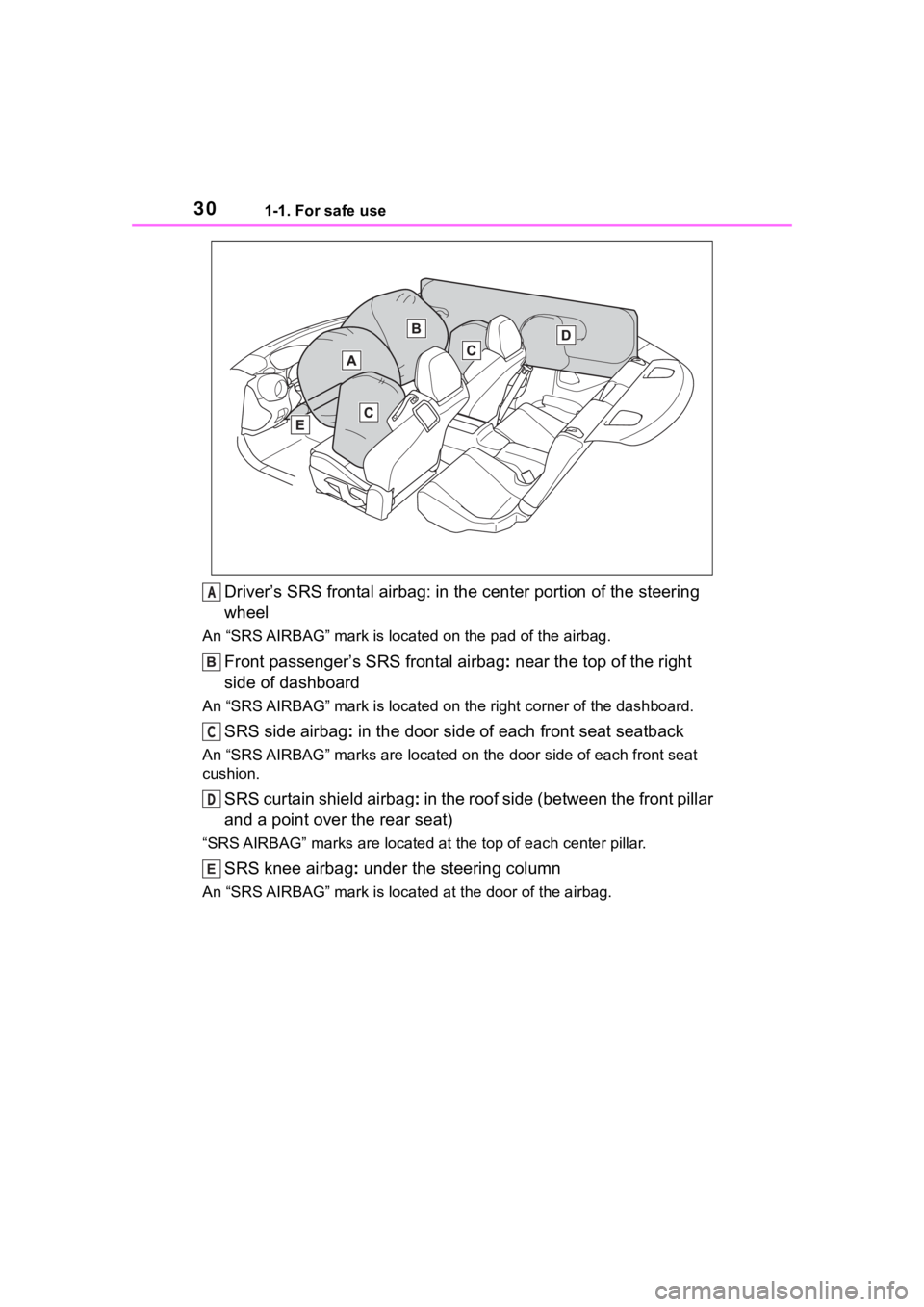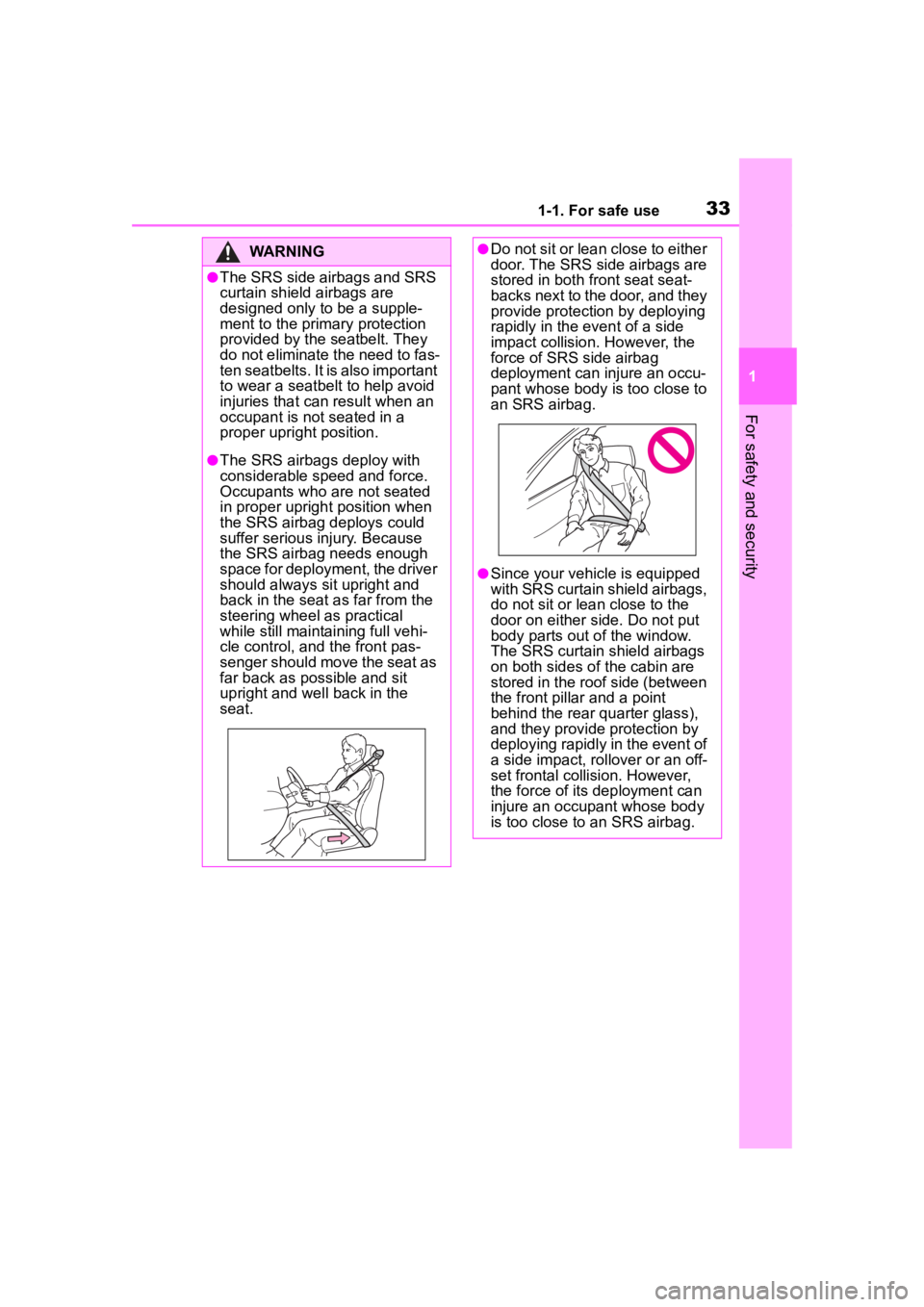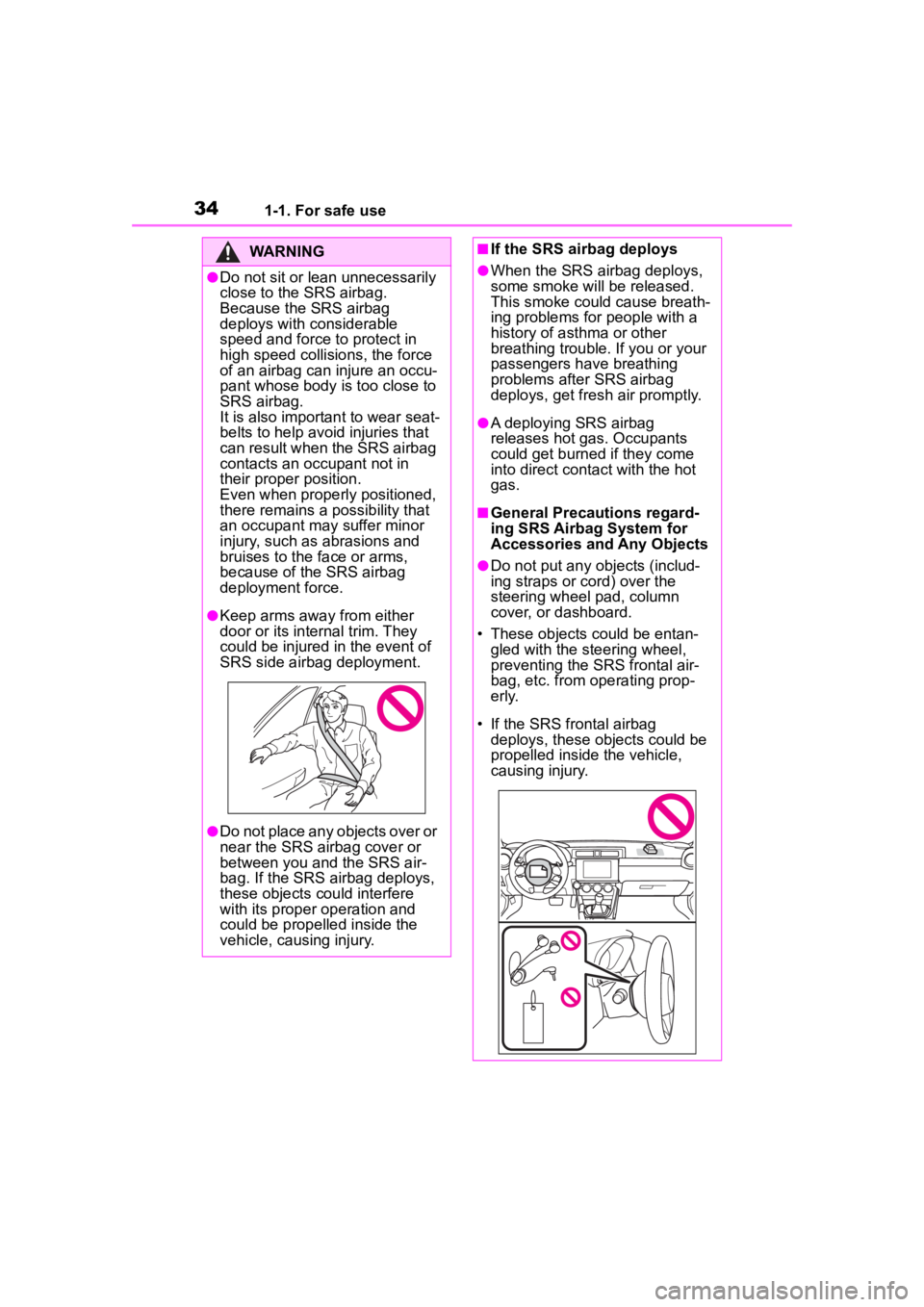2023 TOYOTA 86 wheel
[x] Cancel search: wheelPage 2 of 449

2TABLE OF CONTENTS
For your information ........................5
Reading this manual ...................... 10
How to search ................................ 11
Pictorial index ................................ 12
1-1. For safe use Before driving ........................ 22
For safe driving ..................... 23
Seat belts .............................. 25
SRS airbags .......................... 29
Front passenger occupant clas- sification system.................. 56
Exhaust gas precautions....... 62
1-2. Child safety Riding with children ............... 63
Child restraint systems .......... 64
1-3. Emergency assistance Safety Connect ..................... 75
1-4. Theft deterrent system Engine immobilizer system ... 80
Alarm ..................................... 81
2-1. Instrument cluster Warning lights and indicators............................................ 84
Gauges and meters .............. 88
Multi-information display ....... 93
3-1. Key information Keys ................................... 102
3-2. Opening, closing and locking the doors and trunk
Doors ................................. 105
Trunk .................................. 107Smart key system ..............
111
3-3. Adjusting the seats Front seats ......................... 119
Rear seats.......................... 121
Head restraints................... 123
3-4. Adjusting the steering wheel and mirrors
Steering wheel ................... 125
Inside rear view mirror ....... 126
Outside rear view mirrors ... 127
3-5. Opening, closing the windows Power windows .................. 129
4-1. Before driving Driving the vehicle.............. 132
Cargo and luggage ............ 140
Vehicle load limits .............. 143
Trailer towing...................... 143
Dinghy towing .................... 144
4-2. Driving procedures Engine (ignition) switch ...... 145
Automatic transmission ...... 149
Manual transmission .......... 153
Turn signal lever................. 155
Parking brake ..................... 156
ASC (Active Sound Control) ......................................... 157
4-3. Operating the lights and wip- ers
Headlight switch ................. 158
High Beam Assist ............... 16
2
Windshield wipers an
d washer
......................................... 165
4-4. Refueling Opening the fuel tank cap .. 167
4-5. EyeSight EyeSight............................. 170
1For safety and security
2Vehicle status information
and indicators
3Before driving
4Driving
Page 3 of 449

3TABLE OF CONTENTS
1
2
3
4
5
6
7
8
9
10
Pre-Collision Braking System......................................... 179
Adaptive Cruise Control ..... 190
Conventional Cruise Control ......................................... 207
Pre-Collision Throttle Manage- ment ................................. 215
Lane Departure Warning .... 220
Lane Sway Warning ........... 222
Lead Vehicle Start Alert ...... 224
List of alert/notification sounds ......................................... 226
EyeSight malfunction and tem- porary stop ....................... 228
4-6. Using other driving systems BSD/RCTA ......................... 232
Reverse Automatic Braking (RAB) system ................... 240
Rear view camera .............. 250
Conventional Cruise Control ......................................... 255
Driving mode select switch ......................................... 258
Hill-start assist control ........ 259
Driving assist systems........ 262
4-7. Driving tips Winter driving tips............... 266
5-1. Using the air conditioning system
Automatic air conditioning sys-
tem ................................... 270
Seat heaters ....................... 276
5-2. Using the interior lights Interior lights list ................. 277
5-3. Using the storage features List of storage features ...... 279
Trunk features .................... 2825-4. Using the other interior fea-
tures
Other interior features ........ 283
6-1. Maintenance and care Cleaning and protecting the vehicle exterior................. 288
Cleaning and protecting the vehicle interior.................. 291
Cleaning and protecting the
Ultrasuede
®area .............. 293
6-2. Maintenance Maintenance requirements......................................... 295
General maintenance......... 296
Emission inspection and mainte- nance (I/M) programs ...... 299
6-3. Do-it-yourself maintenance Do-it-yourself service precau-tions ................................. 300
Hood .................................. 302
Positioning a floor jack ....... 303
Engine compartment .......... 305
Tires ................................... 312
Replacing the tire ............... 319
Tire inflation pressure......... 323
Wheels ............................... 325
Air conditioning filter........... 327
Electronic key battery......... 328
Checking and replacing fuses ......................................... 330
Headlight aim ..................... 332
Light bulbs.......................... 333
7-1. Essential information Emergency flashers ........... 338
5Interior features
6Maintenance and care
7When trouble arises
Page 23 of 449

231-1. For safe use
1
For safety and security
Adjust the angle of the seat-
back so that you are sitting
straight up and so that you do
not have to lean forward to
steer. (P.119)
Adjust the seat so that you
can depress the pedals fully
and so that your arms bend
slightly at the elbow when
gripping the steering wheel.
( P.119)
Lock the head restraint in
place with the center of the
head restraint closest to the
top of your ears. ( P.123)
Wear the seat belt correctly.
( P.25)
WARNING
■Before driving
●Check that the floor mat is
securely fixed in the correct
place with all the provided
retaining hooks (clips). Be espe-
cially careful to perform this
check after cleaning the floor.
●With the engine stopped and
the shift lever in P (Automatic
transmission) or N (manual
transmission), fully depress
each pedal to the floor to make
sure it does not interfere with
the floor mat.
For safe driving
For safe driving, adjust the
seat and mirror to an appro-
priate position before driv-
ing.
Correct driving posture
A
C
D
Page 30 of 449

301-1. For safe use
Driver’s SRS frontal airbag: in the center portion of the steering
wheel
An “SRS AIRBAG” mark is loca ted on the pad of the airbag.
Front passenger’s SRS frontal airbag : near the top of the right
side of dashboard
An “SRS AIRBAG” mark is located on the right corner of the dash board.
SRS side airbag : in the door side of each front seat seatback
An “SRS AIRBAG” marks are locat ed on the door side of each front seat
cushion.
SRS curtain shield airbag : in the roof side (between the front pillar
and a point over the rear seat)
“SRS AIRBAG” marks are located a t the top of each center pillar.
SRS knee airbag: under the steering column
An “SRS AIRBAG” mark is locate d at the door of the airbag.
A
C
D
Page 31 of 449

311-1. For safe use
1
For safety and security
■SRS airbag system componentsFront impact sensor (left-hand side)
Front impact sensor (right-hand side)
SRS warning light
Frontal airbag module (driver’s side)
Airbag control module (including impact sensor and rollover sen-
sor)
Front passenger’s frontal airbag ON and OFF indicator
Frontal airbag module (front passenger’s side)
Seatbelt buckle switch (front passenger’s side)
Curtain shield airbag module (right-hand side)
Side impact sensor (door right-hand side)
Side airbag module (fr ont passenger’s side)
Seatbelt pretensioner and adaptive force limiter (front passen-
ger’s side)
Side impact sensor (center pillar right-hand side)
Airbag wiring
Side impact sensor (rear wheel house right-hand side)
Front passenger’s occupant detection system sensor
A
C
D
Page 32 of 449

321-1. For safe use
Side impact sensor (rear wheel house left-hand side)
Side airbag module (driver’s side)
Side impact sensor (center pillar left-hand side)
Seatbelt pretensioner (driver’s side)
Side impact sensor (door left-hand side)
Knee airbag module (driver’s side)
Curtain shield airbag module (left-hand side)
■If the SRS airbag deploys
If the SRS airbag deploys, fuel sup-
ply will be cut off to reduce the risk
of fire caused by leaking fuel. For
details about restarting of the
engine, refer to P.347.
■SRS Airbag System Servicing
In the following cases, contact your
Toyota dealer as soon as possible.
●The front part of the vehicle was
involved in an accident in which
only the driver’s SRS frontal air-
bag or both driver’s and front pas-
senger’s SRS frontal airbags did
not deploy.
●The pad of the steering wheel, the
cover over the front passenger’s
SRS frontal airbag, or either roof
side (from the front pillar to a point
over the rear seat) is scratched,
cracked, or otherwise damaged.
●The center pillar, door, rear wheel
house or rear sub frame, or an
area near these parts, was
involved in an accident in which
the SRS side air bag and SRS cur-
tain shield airbag did not deploy.
●The fabric or leather of either front
seatback is cut, frayed, or other-
wise damaged.
●The rear part of the vehicle was
involved in an accident in which
no SRS airbag was deployed.
■When you sell your vehicle
When you sell your vehicle, we urge
you to inform the buyer that the vehicle is equipped with SRS air-
bags. Also, notify the buyer of the
applicable section in this Owner’s
Manual.
WARNING
■General Precautions regard-
ing SRS Airbag System
●To obtain maximum protection
in the event of an accident, the
driver and all passengers must
always wear seatbelts when in
the vehicle. The SRS airbag is
designed only to be a supple-
ment to the primary protection
provided by the seatbelt. It does
not eliminate the need to fasten
seatbelts. In combination with
the seatbelts, it offers the best
protection in case of a serious
accident.
Not wearing a seat belt increases
the chance of severe injury or
death in a crash even when the
vehicle has the SRS airbag.
For instructions and precautions
concerning the seatbelt system,
refer to P.25.
Page 33 of 449

331-1. For safe use
1
For safety and security
WARNING
●The SRS side airbags and SRS
curtain shield airbags are
designed only to be a supple-
ment to the primary protection
provided by the seatbelt. They
do not eliminate the need to fas-
ten seatbelts. It is also important
to wear a seatbelt to help avoid
injuries that can result when an
occupant is not seated in a
proper upright position.
●The SRS airbags deploy with
considerable speed and force.
Occupants who are not seated
in proper upright position when
the SRS airbag deploys could
suffer serious injury. Because
the SRS airbag needs enough
space for deployment, the driver
should always sit upright and
back in the seat a s far from the
steering wheel as practical
while still maintaining full vehi-
cle control, and the front pas-
senger should move the seat as
far back as possible and sit
upright and we ll back in the
seat.
●Do not sit or lean close to either
door. The SRS side airbags are
stored in both front seat seat-
backs next to the door, and they
provide protection by deploying
rapidly in the event of a side
impact collision. However, the
force of SRS side airbag
deployment can injure an occu-
pant whose body is too close to
an SRS airbag.
●Since your vehicle is equipped
with SRS curtain shield airbags,
do not sit or lean close to the
door on either side. Do not put
body parts out of the window.
The SRS curtain shield airbags
on both sides of the cabin are
stored in the roof side (between
the front pilla r and a point
behind the rear quarter glass),
and they provide protection by
deploying rapidly in the event of
a side impact, rollover or an off-
set frontal collision. However,
the force of its deployment can
injure an occupant whose body
is too close to an SRS airbag.
Page 34 of 449

341-1. For safe use
WARNING
●Do not sit or lean unnecessarily
close to the SRS airbag.
Because the SRS airbag
deploys with considerable
speed and force to protect in
high speed collisions, the force
of an airbag can injure an occu-
pant whose body is too close to
SRS airbag.
It is also important to wear seat-
belts to help avoid injuries that
can result when the SRS airbag
contacts an occupant not in
their proper position.
Even when properly positioned,
there remains a possibility that
an occupant may suffer minor
injury, such as abrasions and
bruises to the face or arms,
because of the SRS airbag
deployment force.
●Keep arms away from either
door or its internal trim. They
could be injured in the event of
SRS side airbag deployment.
●Do not place any objects over or
near the SRS airbag cover or
between you and the SRS air-
bag. If the SRS airbag deploys,
these objects could interfere
with its proper operation and
could be propelled inside the
vehicle, causing injury.
■If the SRS airbag deploys
●When the SRS airbag deploys,
some smoke will be released.
This smoke could cause breath-
ing problems for people with a
history of asthma or other
breathing trouble. If you or your
passengers have breathing
problems after SRS airbag
deploys, get fresh air promptly.
●A deploying SRS airbag
releases hot gas. Occupants
could get burned if they come
into direct contact with the hot
gas.
■General Precautions regard-
ing SRS Airbag System for
Accessories and Any Objects
●Do not put any objects (includ-
ing straps or cord) over the
steering wheel pad, column
cover, or dashboard.
• These objects could be entan- gled with the steering wheel,
preventing the SRS frontal air-
bag, etc. from operating prop-
erly.
• If the SRS frontal airbag deploys, these objects could be
propelled inside the vehicle,
causing injury.